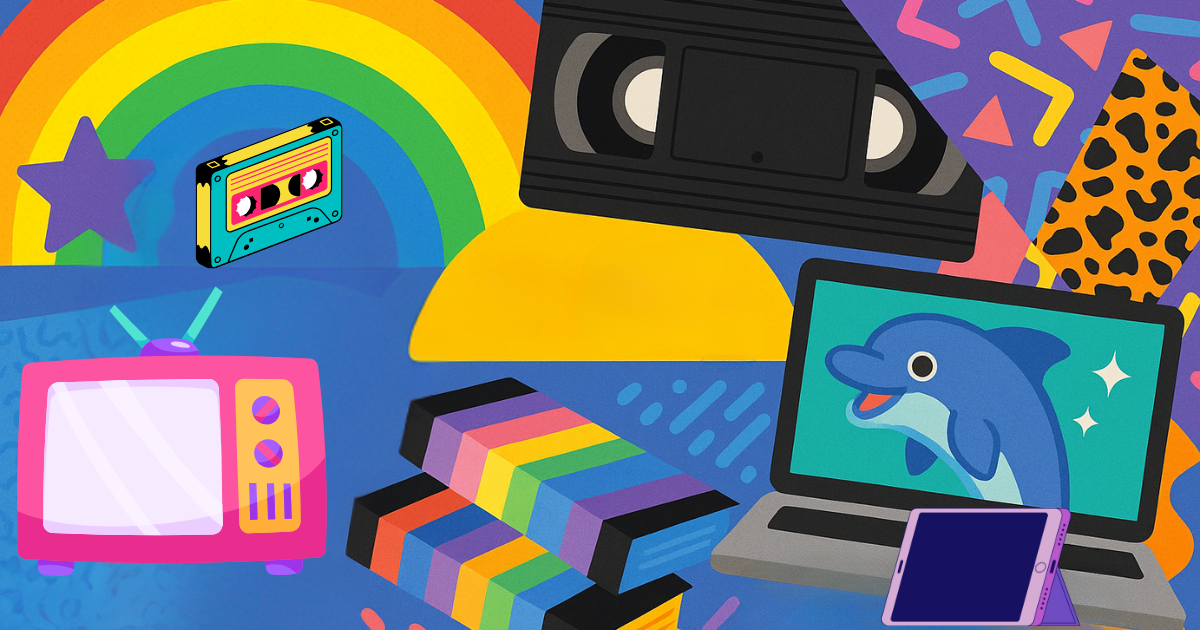If you grew up in the 1980s or 1990s, chances are your afternoons were filled with shows like Sesame Street, Fraggle Rock, Reading Rainbow, Full House, Saved by the Bell, or even My Little Pony. These weren’t just TV shows—they were cultural touchstones, shaping the way kids learned, laughed, and connected with the world around them.
Fast forward to today, and children’s entertainment looks dramatically different. With streaming platforms, YouTube channels, and apps vying for kids’ attention, the pace is faster, the storylines shorter, and the style louder and brighter. But what does this shift mean for kids’ learning and memory? Let’s take a walk down memory lane and see how things have changed.
TV in the ’80s and ’90s: Slow, Steady, and Full of Heart
Back in the day, children’s TV felt like it was made to nurture patience, imagination, and learning.
- Educational depth – Sesame Street taught letters, numbers, and social-emotional lessons in ways that were fun but also paced for a child’s developing brain. Kids had time to process what Big Bird or Grover were saying before the next scene rolled in.
- Storytelling with meaning – Shows like Full House or Saved by the Bell weren’t strictly for kids, but their moral-of-the-story style made them memorable. Problems unfolded slowly, and resolutions tied everything together with a life lesson.
- Imaginative worlds – Fraggle Rock and My Little Pony offered rich, colorful universes, but the storytelling wasn’t rushed. Episodes built arcs that encouraged imagination and play beyond the TV screen.
- Encouraging curiosity – Reading Rainbow stands out as one of the most influential shows for kids’ literacy. It gave kids time to think about books, explore ideas, and let curiosity guide them.
What’s striking about these shows is how much breathing room they had. A single joke might take 30 seconds to unfold. A storyline might stretch across an entire episode. The pace respected a child’s slower processing speed.

Today’s Kids’ TV: Fast, Flashy, and Always Available
Turn on almost any kids’ show today, and the difference is immediate. Bright colors flash across the screen, characters talk at lightning speed, and episodes often pack in multiple micro-stories.
- Quick edits and jump cuts – Inspired by the internet and YouTube culture, kids’ shows today are fast-paced, with constant movement and quick-cut edits to hold attention.
- Shorter narratives – Instead of long story arcs, many shows rely on mini-plots that wrap up in just a few minutes.
- Endless streaming – In the ’80s and ’90s, if you missed your show, you had to wait until it aired again. Today, kids can binge entire seasons in one sitting, rewinding and rewatching their favorite clips endlessly.
- High energy, fewer pauses – Even educational shows are often designed to compete with apps and games. This means faster pacing, higher stimulation, and less “quiet time” for reflection.
The accessibility and variety of kids’ programming today is impressive. There’s content for every interest, from science experiments to cooking to fantasy adventures. But the tradeoff is that much of this content is designed to keep kids’ attention glued to the screen, rather than allowing their minds to wander and imagine.
The Impact on Kids’ Learning and Memory
So how does this shift affect children? Research shows that pacing and storytelling style play an important role in how kids learn and remember information.
Attention spans are shrinking – When kids are constantly fed rapid-fire entertainment, their brains adapt to expect constant stimulation. Sitting still for a book, a classroom lesson, or even a slow-paced movie can feel harder.
Shallow narratives mean less memory retention – Slower stories with clear beginnings, middles, and ends help children organize information in their memory. Quick, fragmented stories don’t always stick in the same way.
Critical thinking takes a hit – Older shows often encouraged problem-solving and reflection. Modern quick-hit shows may focus more on excitement than teaching kids how to think deeply.
The dopamine effect – Fast-paced shows trigger quick bursts of dopamine (the brain’s “feel-good” chemical). This makes them addictive but doesn’t always translate into meaningful learning.
This isn’t to say modern shows are all bad. Some are brilliantly creative and inclusive, representing cultures, families, and ideas that were absent in earlier decades. But when it comes to learning and memory, the pacing and style matter.
What Parents Can Do: Finding Balance in Screen Time
The good news is, parents don’t have to choose between old and new. You can balance both worlds to help kids get the best of each.
- Mix in classic shows – Many older shows (Reading Rainbow, Sesame Street, Mr. Rogers’ Neighborhood) are available on streaming platforms. Adding them into your kids’ viewing rotation helps balance pace and depth.
- Watch together – Co-viewing allows you to pause, ask questions, and encourage reflection. Even fast-paced shows can spark deeper conversations if you guide your child through the storyline.
- Encourage off-screen play – The slower pacing of older shows often inspired kids to re-enact stories with toys or friends. Encourage your kids to take what they see on screen and bring it into imaginative play.
- Set limits on binge-watching – Streaming makes it easy to watch multiple episodes, but setting boundaries helps kids practice patience and memory retention between episodes.
- Use shows as tools – A silly cartoon might not be deeply educational, but it can still be a reward or a mood booster. Meanwhile, slower, more thoughtful shows can be intentionally chosen for learning moments.
Nostalgia Meets Modern Parenting
For many of us, thinking about Sesame Street, Full House, or Fraggle Rock brings a warm sense of nostalgia. These shows didn’t just entertain us; they shaped the way we saw the world. While today’s kids’ shows are faster, brighter, and more accessible than ever, there’s something timeless about the slower, story-driven style of the past.
The challenge—and opportunity—for parents today is to blend the best of both worlds. Encourage your kids to enjoy the creativity and diversity of modern programming, but don’t forget the value of slowing down, rewatching a classic, and giving children time to let stories sink in.
Why Slower, Classic Kids’ Shows Still Matter in the Streaming Era
Children’s television has always reflected the times. The ’80s and ’90s gave us patient, lesson-driven programming designed for developing minds. Today’s streaming era delivers constant entertainment, often at lightning speed. Both eras have something to offer, but when it comes to kids’ learning and memory, slowing down still has its benefits.
So maybe this weekend, alongside the latest trending kids’ show, queue up an episode of Reading Rainbow or Sesame Street. You might be surprised how well those timeless lessons still hold up—and your kids might just fall in love with them, too.





